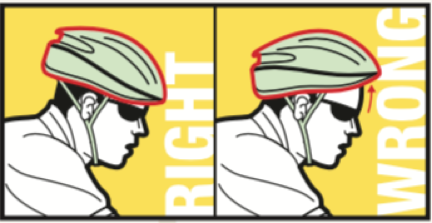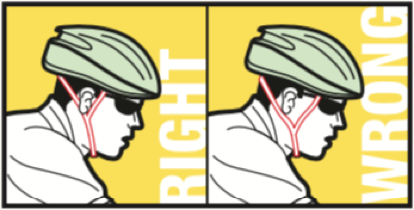INJURY PREVENTION
Use Your Head, Wear a Helmet
How to Wear a Bike Helmet: Snug, Level & Low
Your helmet cannot protect what it does not cover. If your helmet does not fit snugly on your head, or if it tips back (leaving your forehead exposed), it can slide or fall in a crash - and you are twice as likely to suffer a serious head injury.
SNUG. Choose a helmet that fits snugly all around your head and use the inside pads to adjust for fit and comfort. Your front and rear straps should attach in a "Y" just below your ear. Your straps should able pulled tightly but comfortably up against your skin and you should be able to slide a finger under the strap.
LEVEL. Your helmet should be level, not tilted for backward, it should not be able to move from side to the other. Take a look in the mirror or ask a friend or family member to check that it is level.
LOW. Your helmet should sit squarely on your head with the front of the helmet low on the forehead, above your eyebrows. Now for the test. Check your helmet fit by looking in a mirror. Gently rotate the helmet on your head, front to back and side to side. Note how your skin moves in your brow area. If tis comfortable, and the skin moves with the helmet you have a proper fit.
Bicycle Helmets: Quick Questions, Quick Answers.
Q. Who should wear a helmet?
A. ANYONE WITH A BRAIN. You wear a seat belt when you’re in a car, right? Think of a helmet as a seat belt for your brain. It’s easy, cheap and smart. If that’s not enough of a reason, California law requires anyone under age 18 to wear a helmet while riding a bicycle, scooter, skateboard or skates. Of course, everyone over 18 should wear one, too.
Q. Where can I buy a helmet?
A. Your local bike shop will have the best selection. Check the yellow pages or the Web. Many department stores also carry helmets. Never buy a used helmet.
Q. What features should I look for?
A. Make sure it has been tested and approved by the Consumer Product Safety Commission (CPSC). This is usually indicated by a “CPSC” sticker in the helmet. All helmets with CPSC stickers are approved. Also consider options such as a visor to block the sun, or an attachment for a rear light.
Q. How much should I pay for a helmet?
A. Functional helmets can be found for as little as $20—a small price to pay to protect your brain. Some helmets are lighter, include more features and include more vents to keep your head cool. Of course, the more features, the higher the cost.
Q. How should a helmet fit?
A. Helmets must be SNUG, BUCKLED AND WITH NO SLACK IN THE STRAPS. Wear your helmet level, NOT TILTED BACK! A helmet that is too loose or tilted back will not provide adequate protection from a head injury. Some models have different sizes for better fit. If you buy a one-size fits all helmet, be sure to buy some inexpensive foam inserts to adjust the size and fit of the helmet to your head.
Q. When should I replace my helmet?
A. Replace your helmet AFTER A FALL OR CRASH that causes an impact to the helmet, even if you don’t see any cracks or dents. If your helmet hasn’t been in a fall or crash, you should still replace it ever 3-5 years. Over time, sunlight and regular usage both weaken the helmet. The more you use it, or the more you leave your helmet in the sun, the sooner you should replace it.
Q. About Multi-Sport Helmets
A. Multi-sport helmets are designed for multiple impacts as found in skateboarding and trick or free style skating, and are of a different design and construction. The outer shell is ABS plastic like football and hockey helmets; its hard plastic spreads and tempers the impact.
Bicycle helmets are good for only one impact. It doesn’t matter how much you paid! One crash and the helmet needs to be replaced.
According to the Bicycle Helmet Safety Institute, you should look for a sticker that says ASTM F-1492 or Snell-94 when buying a helmet for skateboarding or radical styles of skating.
Resurces
Use Your Head, Wear a Helmet - English | Español | Tiếng Việt





